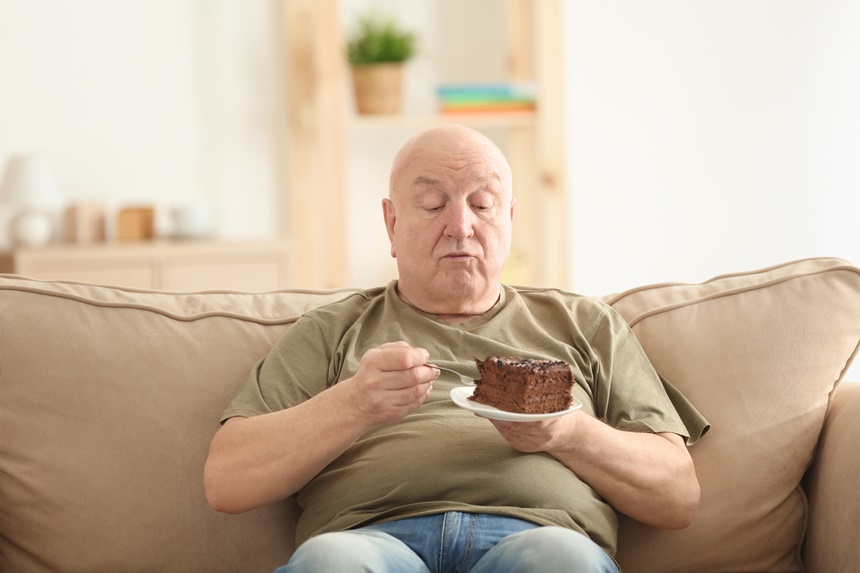We are pleased to bring you this regular column by Dr. David Creel, a licensed psychologist, certified clinical exercise physiologist and registered dietitian. He is also credentialed as a certified diabetes educator and the author of A Size That Fits: Lose Weight and Keep it off, One Thought at a Time (NorLightsPress, 2017).
Do you have a weight loss question for Dr. Creel? Email him at [email protected]. He may answer your question in a future column.
Practice Messing Up
Yes, you read correctly, and not everyone agrees with me on this one. Practice messing up — eat junk food? Isn’t that like telling an alcoholic to drink just a little bit?
I wouldn’t give this advice to an alcoholic, but food isn’t the same as alcohol. We have to eat in order to survive. Alcohol is optional and we can choose to totally abstain from it. When it comes to food, we must manage our diet in one way or another. Labeling foods unhealthy and then totally abstaining from all of them can be an overwhelming and unnecessary task. Where should you draw the line? The list can become endless and leads to frustration. You start feeling guilt about eating from the wrong list, like an addict who hijacked his recovery.
Wouldn’t it be nice to enjoy not-so-healthy food without feeling like you messed up each time? Practicing is the only way to do this. I’ve met many folks who view certain foods as bad and when they eat that food they are being bad. They associate ice cream, fudge, or gooey chocolate chip cookies with lack of willpower or being out of control. Over time this view becomes part of a self-fulfilling prophesy. When they eat something loaded with fat and sugar they view themselves as out of control. As a result of these beliefs, they eat the dessert in an out-of-control way. Guilt prevents them from enjoying the food, and sometimes they shame themselves back to eating only from the healthy-food list. At other times, especially when their defenses are down, they veer way off track. It’s sort of a shame.
It’s true that we don’t need Ho Hos, Doritos, or bacon double-cheeseburgers served between two doughnuts, and it may be a good idea to add a few items to the “Food I Refuse to Put in My Mouth” list. Yet some foods give us a great deal of pleasure, even though they have little redeeming value. We can make these foods fit into an overall healthy diet. Here’s what happened during a meeting with a patient named Theresa:
Theresa smiled at me and said, “So let me get this straight. My assignment for this week is to eat chocolate?”
“It is,” I said. “Look, you really enjoy chocolate and you don’t want to entirely cut it out of your diet, right?”
“That would be accurate.”
“So, to me, it makes sense to practice eating it so you have a sense of control and confidence when you do.”
Several times per week, usually on the weekends, Theresa ran errands and would have an intense craving for chocolate. Sometimes she resisted the cravings but at other times she gave in — and gave in big time. With urgency in her step and intention in her eyes, she’d grab a bag of chocolate miniatures at the self-checkout line. She knew she was breaking the rules so she had to do it fast, before logic could prevail. She would then get in her car and rapidly devour half the bag before slowing down. Defeated, she would finish the bag of chocolates while sitting in the parking lot of the grocery store. She discarded all evidence — receipts, wrappers and the candy bag — before driving home, hoping to forget anything out of the ordinary happened. Our conversation went something like this.
“So tell me how much you enjoy these bags of chocolate,” I said.
“At first it tastes very good, I guess, but it’s also like getting rid of a craving.”
“So it’s taking something unpleasant away, the craving, as well as giving you pleasure?”
“Exactly. At times the chocolate isn’t as good as I think it’s going to be. It reminds me of how I used to crave cigarettes even though I didn’t always enjoy smoking. Sometimes I liked it quite a bit, but sometimes I smoked just to get relief from the craving.”
“That makes sense,” I said. “Now I want you to imagine that eating chocolate is okay, for just a minute. Maybe you can think of chocolate as God’s gift just for you! It’s not wrong in any way for you to eat it.”
“That sounds nice,” she said, as she opened her eyes wide and wrapped her thumb and index finger around her chin.
“You don’t have to fight wanting it with I shouldn’t have it,” I said.
“I like that idea,” she said, nodding her head.
“If you felt this way, how much chocolate would you eat before you stopped?”
“Oh, I’ve never thought of chocolate that way. I don’t know exactly, but probably half of the bag or less.”
“Why less than you eat now?”
“I eat the second half of the bag because I’ve already messed up and it’s sitting right beside me in the passenger’s seat.”
“Now I want you to consider the value of the chocolate to you. Let’s use an analogy: When is the last time you bought a car?”
“I bought one two years ago,” she said.
“Was it new or used?”
“It was new, the only new car I’ve ever owned.”
“How did you make that decision?”
She shrugged. “I thought about what I wanted and how much I was willing to pay for it.”
“So cost was a consideration?” “Absolutely.”
“Let’s think about your chocolate this way,” I said. “You want it, but there are costs, such as calories, how you feel after eating, etcetera. How many calories are you be willing to spend to get what you want?”
“The first seven or eight miniatures are really enough for me. I would feel like I got my chocolate fix and it was in my budget. I think they’re about 30 calories each, so I would spend 200 to 250 calories.”
“Would you feel deprived?”
“I’m not sure, but I don’t think so. I’d actually feel like I got what I wanted in two different ways—I got some chocolate and I stayed within a reasonable calorie budget. Sure there’s a little restriction; if I were God I’d make chocolate calorie free!”
“What we just did together—can you do it on your own this week?”
“You mean eat seven or eight pieces of chocolate?”
“Well maybe, but I believe the way you think about chocolate is the first step.”
“Okay, but do you really want me to eat some after I’ve thought about it?”
“I think practice may help you, but I’m not sure if buying a whole bag of chocolate is the best way to approach this. Even if we work on your thoughts, having a whole bag beside you is difficult to resist. Do you think you could deal with the whole bag?”
Laughing, “No; I think it would be too hard for me to stop.”
“Do you like any candy bars as much as you like the miniatures?” I asked.
“Actually I do. I guess in my mind I’m always telling myself I’ll just eat a few pieces per day, so I buy the minis.”
“How about if we plan on buying a candy bar this week?”
“You’re giving me permission?” she asked.
“Yes, but can you give yourself permission?”
“I think so.”
“I also want you to try to eat slowly and enjoy it. Take small bites and savor each one. You might even glance at your watch and see how long it takes you to eat it like this.”
“Should I do this each time I have a craving?”
“What do you think is the best approach?”
“I don’t think that’s a good idea, because what if I have a craving every day or twice per day?”
“Good point. You’ve used a lot of good methods to ride out cravings in the past. I suggest you continue using strategies like distraction, waiting 30 minutes before you decide whether or not to eat, or distracting yourself with a fun activity.” I paused to let my words sink in, then added, “But I still think you need to practice eating chocolate in a healthier way. Let’s get specific about how you can have a guilt-free rendezvous with your candy bar.”
“I think Saturday afternoon is the best time. I would enjoy it most because, although I’m running errands, I’m not in a hurry. “
“Where do you want to eat it?”
“I know people say you should eat at the table, but I just don’t think that will work for me. I like taking a break in my car. I tend to associate eating in the car with a binge, so maybe if I practice eating less while in the car it won’t be such a problem in the future. Can I try it in my car? I’ll just sit in the grocery store parking lot and listen to the radio — I won’t drive and eat.”
“That sounds reasonable for now,” I said. “I do think you may like eating in the car because it’s private and somewhat secretive, but we can talk about that later. Let’s give it a shot for this week.”
Theresa continues to work on controlling her chocolate intake. Many times her goal is to abstain from chocolate altogether. But our practice with moderation has increased her confidence in eating smaller amounts of one of her favorite foods. When she eats chocolate according to her plan, she experiences guiltless pleasure and satisfaction. She also maintains her 30-pound weight loss.
The best practice is one you think through ahead of time. We all have many activities, like vacations, holidays, weekends at the lake, or running errands that make managing weight more difficult. If we want to become better at loosening but not letting go of the reins, we need a plan before we practice. When we make a plan and follow it, we feel like we’re on track — which is crucial when the plan involves deviating somewhat from our usual healthy eating and physical activity regimen. I caution you against a common error related to practicing eating the foods we crave: rationalization. It’s tempting to start viewing all our dietary indiscretions as practice, when in fact they aren’t. Healthy practice requires forethought rather than an explanation after the fact. Your plans should be somewhat systematic with specific and measurable goals. After the practice, evaluate your experience and plan for the next session.
Looking for Lessons
I was wrong, I made a mistake, my plan didn’t work and your idea was better. Those are hard phrases for me to say — and words my wife loves to hear.
–Henry Ford
Life is filled with learning experiences, and the more we try to do, the more we learn. Stretching ourselves brings the risk for failure — but we often learn more from failure than from success. As Henry Ford said, “Failure is the opportunity to begin again more intelligently.” When we use failure to make adjustments, we’re still making progress. And so it is with weight management. When you give in to food temptation or stop exercising after an exhausting week, it’s tempting to forget the whole thing and start over. But if you start over without evaluating what went wrong, you’re likely to make the same mistakes again.
After a few weeks off for the Christmas holidays, many of my clients come into the office and say, “I need to get back on track.” They lay out plans to get to the gym on a regular basis, eat “clean,” and start recording their food again.
I agree with getting back on track, but I also ask them to review what happened so they can be more prepared next season. In fact, I often ask patients to write about their holiday experience: What went well, what didn’t work, and how they could handle it better. These holidays come every year, so the temptation is predictable. For many people the “holiday eating season” begins before Halloween with trick-or-treat candy and lasts until January. That’s two months, or one-sixth of the entire year. It makes sense to learn from the previous year and develop a plan that will lead to a guilt-free and enjoyable season.
Become a Saturday Evening Post member and enjoy unlimited access. Subscribe now



